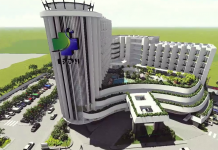he initiative to reclaim the prewar ‘Little Tokyo’, referring to the 600-hectare agricultural land known as Mintal, a district southwest of Davao City, was first broached in 2009 by Ra-mon Bargamento II, the elected village chief of the huge barangay, and his barangay council.
The village declared the old settlement as “Japanese Heritage Area” that same year.
To put on track the ‘Little Tokyo’ revival, the Davao City Council, this city’s lawmaking body, through its Committee on International Relations, approved also in 2009, a resolution supporting the move of barangay Mintal to declare a heritage site in the village, notably the central area where the heart of Japanese investment was flourishing prior to the outbreak of World War II.
The initial concept was to build a Japanese-theme park and reconstruct the relic sites in time for that year’s influx of Japanese tourist, normally during the Kadayawan Festival. To fast-track the project, the city enlisted the support of Philippine Nikkei Jin Kai Inc., Davao City Investment Promotion Center and the Davao Historical Society Foundation, Inc., to name a few.
Time constraint and lack of funding stalled the early move. It was only in 2014 when the City Tourism Office (CTO) under Lisette Marques put in earnest the push to really restore “the remnants and ruins of the once Japanese colony in barangay Mintal.” To expedite the move, a blueprint was submitted to Tourism Infrastructure and Enterprise Zone Authority (TIEZA), a subsidiary of the Department of Tourism.
Relics from the past
To authentically restore the former Japanese enclave, city officials were one in mind in ad-dressing the issue of informal settlers in the area where a Japanese hospital once stood. As part of the broader plan to reclaim the historical significance, CTO also planned the integration of a heritage tour as a later adjunct to the restoration.
The future conservation efforts will include a visit to the famous Ohta obelisk, the decom-missioned water catchment system known to locals as poso, the graveyard stele inside the Japanese cemetery, the badly damaged concrete pyramid, the hospital ruins, and the Okinawan base where migrant workers in abaca plantations built a small community.
Mintal’s significance, moreover, can be found in oral history. Old timers say the name of the barangay was adopted in remembrance of a certain Datu Intal, a Bagobo leader, while other researches argue it’s a combination of the Japanese Mintaro and the chieftain’s name.
Moreover, Mintal, host to the largest prewar Japanese population in the country at the time, was the site of the city’s first Japanese abaca plantation and arguably the most progressive settlement outside the central business district in the town proper.
Overall, around 20,000 Japanese, a fifth of the entire Davao City population then lived in the city before the conflict broke out.
Interested players
By 2016, the reconstruction of the old Mintal took off. TIEZA, to its credit, invited consult-ants to join the project which, by January that year, already had nine submissions. A shortlist of the P10-million tourism consultancy was later drawn up by TIEZA, and trimmed down to three after the conduct of stringent evaluations.
Electoral events would temporarily stall the project until a new mayor had assumed. Fol-lowing the takeover of Sara Duterte-Carpio as new city chief executive on June 30, 2016, and the appointment of a new city tourism officer, the ‘Little Tokyo’ project went full blast. Months later, TIEZA awarded the making of the master plan to Berkman International, Inc., a consulting and management firm.
The conservation plan will feature, among others, a hospital, cemetery, market, stele, markers, and obelisk that bring back the glory of ‘Little Tokyo.’ Primarily, this development hopes to draw more Japanese tourists to the city, which annually reaches 13,000. Even more significant is the opening of public awareness to the agricultural legacy the Japanese left behind as a result of the abaca boom, and as a tribute to the contributions they made in the development of the city.
To ensure the project will really push through, TIEZA had set aside a P120-million appro-priation for the restoration, conservation, and reconstruction of a place the urban planners dub as the forerunner of development that ignited the growth of the old town into a city.
Icing on the cake
Davao’s ‘Little Tokyo’ project took a dramatic turn last January 2017 with the visit of Japanese Prime Minister Shinzo Abe in Davao City. It was not only the first visit of a Japanese head of state to the city, it was also a reminder that in prewar times, before the country was drawn into a bloody conflict, Davao was the world’s largest source of abaca hemp.
As part of the sentimental journey, Abe’s wife, Akie, visited the marker at the Japanese cemetery in Mintal. It was, so to speak, the icing on the cake for a politically correct effort at reclaiming Davao’s history, and the influence it has contributed to the city’s growth and development.
One must not forget also that ties with Japan date back to the second decade of American rule. The Japanese consular office in Davao was opened in March 1920 and was an annex of the Manila Consulate, which later became a full-blown embassy (on February 6, 1932), in response to the growing Japanese population. This development added more impetus to the elevation of Davao as an attractive Japanese investment area.
As a result of World War II, the Japanese consulate, an important diplomatic landmark, was closed but later reopened as links between Japan and the Philippines returned to normal.





